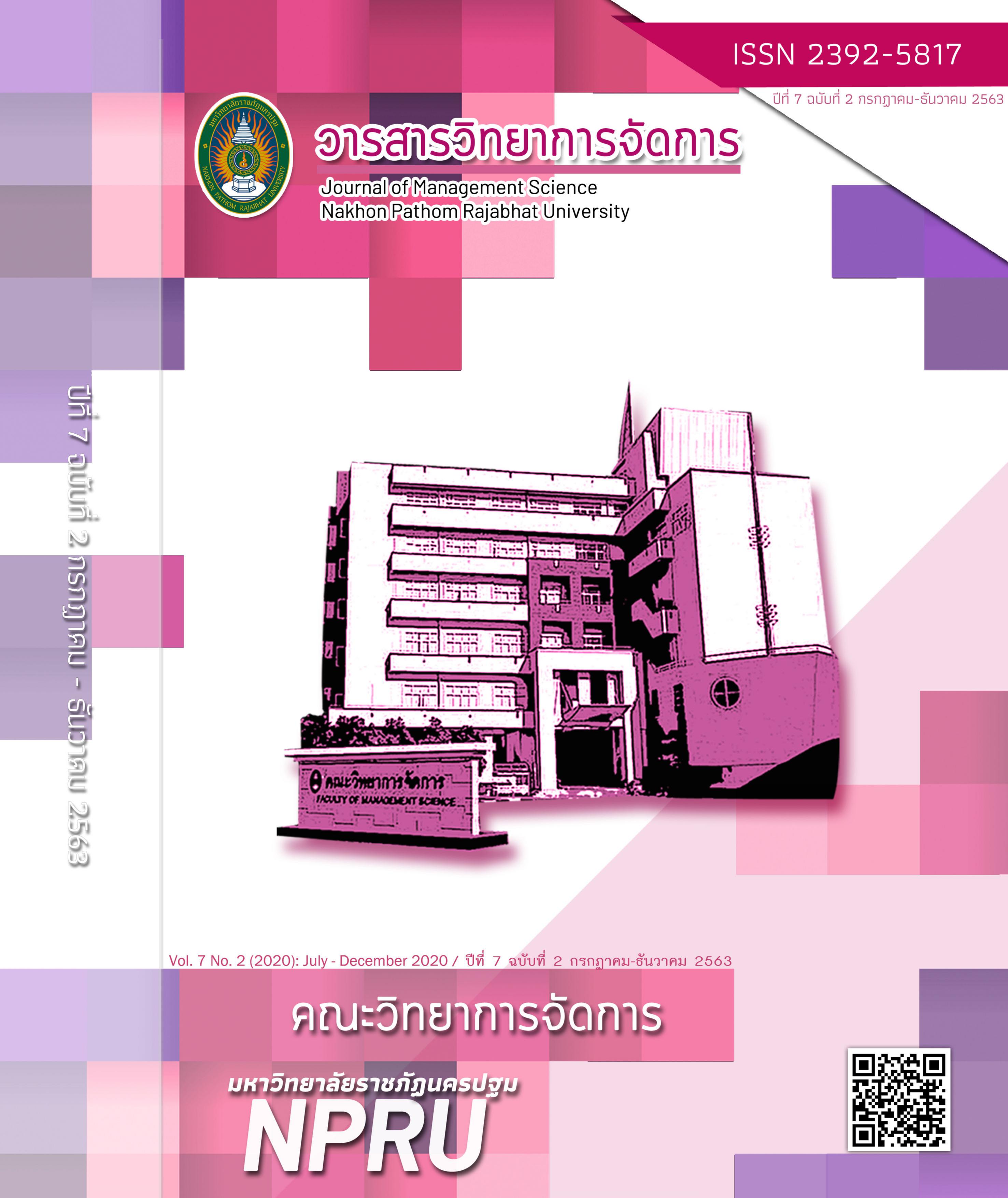ประสิทธิผลการขับเคลื่อนยุทธศาสตร์แหล่งท่องเที่ยวตามอัตลักษณ์วิถีไทย ในเขตกรุงเทพมหานคร
Main Article Content
บทคัดย่อ
วัตถุประสงค์ของการวิจัยนี้มี 3 ประการ คือ 1) เพื่อศึกษาประสิทธิผลของการขับเคลื่อนยุทธศาสตร์แหล่งท่องเที่ยวตามอัตลักษณ์วิถีไทยในเขตกรุงเทพมหานคร 2) เพื่อศึกษาแนวทางการบูรณาการระหว่างภาครัฐ ภาคเอกชน ในการขับยุทธศาสตร์และแหล่งท่องเที่ยว และ3) เพื่อนำเสนอและรับรองยุทธศาสตร์แหล่งท่องเที่ยว ตามอัตลักษณ์วิถีไทยในเขตกรุงเทพมหานคร
การวิจัยนี้มีลักษณะเป็นการวิจัยเชิงคุณภาพ กลุ่มตัวอย่างประกอบด้วยผู้ให้ข้อมูลสำคัญ 22 คน ประกอบไปด้วยบุคคลที่มีความรู้ความสามารถระดับสูงจากภาครัฐ ภาคเอกชน และภาคประชาชน ข้อมูลที่เก็บได้มาทำการวิเคราะห์โดยอาศัยใช้การวิเคราะห์เนื้อหา
การวิเคราะห์ข้อมูลเชิงคุณภาพได้เปิดเผยแทนข้อเท็จจริง ดังที่ระบุข้างล่างนี้
1. ในเรื่องประสิทธิผลของการขับเคลื่อนยุทธศาสตร์แหล่งท่องเที่ยวตามอัตลักษณ์วิถีไทย นั้นกล่าวได้ว่ามีการเน้นในเรื่องความเติบโตทางเศรษฐกิจเป็นสำคัญ กล่าวอีกนัยหนึ่ง มีการเน้นในเรื่องการสร้างรายได้ และความรุ่งเรืองทางเศรษฐกิจ ในการที่จะให้บรรลุเป้าหมายดังกล่าว มีความเพียรพยายามอย่างมาก เพื่อสร้างแผนต่างๆ โดยมีจุดมุ่งหมาย เพื่อจัดและสนับสนุนกิจกรรมต่างๆเกี่ยวกับการท่องเที่ยว และรักษาจุดแข็งที่โดดเด่นของประเทศไทย โดยเฉพาะอย่างยิ่งในด้าน ธรรมเนียม ประเพณี และวัฒนธรรม เป็นที่คาดหวังว่า รายได้ที่ได้มาจากการท่องเที่ยวจะกระจายจากเมืองหลวงไปสู่เมืองรองในลักษณะยั่งยืน
2. ในเรื่องแนวทางในการบูรณาการ ภาครัฐ ภาคเอกชน และภาคประชาชนเพื่อขับเคลื่อนยุทธศาสตร์แหล่งท่องเที่ยวตามอัตลัดษณ์วิถีไทยนั้น หน่วยงานต่างๆจากภาครัฐ ภาคเอกชน และภาคประชาชน ได้แนะนำแหล่งท่องเที่ยวใหม่ๆ และนำเสนอมุมมองใหม่ๆทางด้านการท่องเที่ยว ยิ่งไปกว่านั้น เจ้าหน้าที่ระดับสูงจากหน่วยงานเหล่านั้น ได้ส่งเสริมและให้การสนับสนุนแก่แหล่งท่องเที่ยวที่มีลักษณะโดดเด่น และมีเอกลักษณ์ไทย โดยพิจารณาถึงความยั่งยืน และคุณภาพของแหล่งท่องเที่ยวด้วย
3. โดยอิงสิ่งที่ค้นพบจากการวิจัย ได้ข้อเสนอและรับรองยุทธศาสตร์แหล่งท่องเที่ยว ตามอัตลักษณ์วิถีไทยในเขตกรุงเทพมหานครดังต่อไปนี้
3.1. ควรพัฒนาพื้นที่ และเครื่องอำนวยความสะดวกต่างๆ ทางด้านการท่องเที่ยว รวมทั้งโลจิสติกส์ทางด้านการท่องเที่ยวตลอดจนส่งเสริมความปลอดภัยของนักท่องเที่ยว
3.2. การขับเคลื่อนกลยุทธการท่องเที่ยวตามอัตลักษณ์วิถีไทย จะต้องมีการพัฒนาทรัพยากรมนุษย์ และผู้ประกอบการทางด้านการท่องเที่ยว ในลักษณะที่สอดคล้องต้องกันกับระบบการจัดการสารสนเทศทางด้านการท่องเที่ยว นอกจากนี้ กฎหมายที่ล้าสมัยและการบังคับใช้กฎหมายที่ไม่ได้ผล ควรจะได้รับการปรับปรุงและแก้ไขเสียใหม่
3.3. ควรจะพยายามในทุกทางเท่าที่จะเป็นไปได้ เพื่อส่งเสริม ความหลากหลายทางด้านภูมิสังคม และวัฒนธรรม เพื่อเพิ่มมูลค่า และยกระดับการบริหารจัดการทางด้านการท่องเที่ยวในเขตกรุงเทพมหานครให้มีประสิทธิผล และประสิทธิภาพให้สูงขึ้น
* นักศึกษาหลักสูตรปริญญารัฐประศาสนศาสตรดุษฎีบัณฑิต คณะรัฐศาสตร์ มหาวิทยาลัยกรุงเทพธนบุรี 10170. ดุษฎีนิพนธ์ภายใต้การดูแลของรองศาสตราจารย์ ดร.สถิตย์ นิยมญาติ
Corresponding author : siripat_on@yahoo.com
Article Details
ทัศนะและข้อคิดเห็นของบทความที่ปรากฏในวารสารฉบับนี้เป็นของผู้เขียนแต่ละท่าน ไม่ถือว่าเป็นทัศนะและความรับผิดชอบของกองบรรณาธิการ
เอกสารอ้างอิง
กรมการท่องเที่ยว. (2560). แผนยุทธศาสตร์การพัฒนาแหล่งท่องเที่ยวของประเทศ พ.ศ. 2560-2564. กรุงเทพมหานคร: พีดับบลิว ปริ้นติ้ง.
ฉันทัช วรรณถนอม. (2552). ความหมายและความสำคัญของอุตสาหกรรมการท่องเที่ยว. [ออนไลน์] ค้นเมื่อ 11 มกราคม 2560 จาก https://tourismatbuu.wordpress.com
ติน ปรัชญพฤทธิ์. (2552). การพัฒนาองค์การสมัยใหม่. เอกสารประกอบการสอน. บัณฑิตวิทยาลัย มหาวิทยาลัยเจ้าพระยา.
นิศา ชัชกุล. (2550). อุตสาหกรรมการท่องเที่ยว. กรุงเทพมหานคร :สํานักพิมพ์แห่งจุฬาลงกรณ์มหาวิทยาลัย.
นุชนาฎ เชียงชัย.(2558). การใช้อัตลักษณ์เพื่อการส่งเสริมการท่องเที่ยวของจังหวัดลําปาง. วิทยานิพนธ์ปริญญาบริหารธุรกิจมหาบัณฑิต.หลักสูตรบริหารธุรกิจมหาบัณฑิต.บัณฑิตวิทยาลัย. มหาวิทยาลัยศิลปากร.
บุญเลิศ จิตตั้งวัฒนา. (2548). อุตสาหกรรมการท่องเที่ยว. กรุงเทพมหานคร: เพรส แอนด์ดีไซน์.
พจนา สวนศรี. (2546). คู่มือการจัดการท่องเที่ยวโดยชุมชน. กรุงเทพมหานคร : โครงการท่องเที่ยวเพื่อชีวิต และธรรมชาติ
พรสวรรค์ มโนพัฒนะ. (2553). อุตสาหกรรมการท่องเที่ยวเบื้องต้น. (พิมพ์ครั้งที่ 8.) กรุงเทพมหานคร : โรงพิมพ์มหาวิทยาลัยกรุงเทพ.
ไพรัตน์ เตชะรินทร์. (2547). แนวคิดเกี่ยวกับการมีส่วนร่วมของประชาชน.กรุงเทพมหานคร : ศักดิ์โสภาการพิมพ์.
ภาวิดา รังษี. (2550).ความร่วมมือระหว่างองค์กรภาครัฐ เอกชนและชุมชน ในการจัดกิจกรรมการท่องเที่ยวเชิงอนุรักษ์ กรณีศึกษาบ้านแม่กำปองกิ่งอำเภอแม่ออน จังหวัดเชียงใหม่.วิทยานิพนธ์รัฐศาสตรมหาบัณฑิต (การเมืองและการปกครอง) .มหาวิทยาลัยเชียงใหม่.
ราชบัณฑิตราชสถาน. (2555). พจนานุกรมศัพท์เศรษฐศาสตร์ : ฉบับราชบัณฑิตยสถาน. (พิมพ์ครั้งที่ 2) กรุงเทพมหานคร : ราชบัณฑิตยสถาน.
วรสุดา สุขารมณ์. (2552). ความร่วมมือระหว่างองค์การในการพัฒนาอุตสาหกรรมการท่องเที่ยวไทย. ดุษฎีนิพนธ์ปรัชญาดุษฎีบัณฑิต. สาขารัฐประศาสนศาสตรดุษฎีบัณฑิต. มหาวิทยาลัยรามคำแหง.
ศิริลักษม์ ตันตยกุล. (2557).การนํานโยบายพัฒนาการท่องเที่ยวของแหล่งมรดกโลกทางวัฒนธรรมไปปฏิบัติ.ปรัชญาดุษฎีบัณฑิต.สาขาวิชารัฐประศาสนศาสตร์. มหาวิทยาลัยรามคำแหง.
ศุภชัย ยาวะประภาษ. (2552). นโยบายสาธารณะไทย : กำเนิด พัฒนาการและสถานภาพของศาสตร์ กรุงเทพมหานคร : จุดทอง.
สำนักยุทธศาสตร์และประเมินผล. (2556). แผนบริหารราชการกรุงเทพมหานคร พ.ศ. 2556-2560. กรุงเทพมหานคร: ศูนย์สารสนเทศกรุงเทพมหานคร.
Agranoff, R., and McGuire, M. (2003). Collaborative public management: New strategies for local governments. Washington, D.C.: Georgetown University Press.
Osborne, S.P. (2010). The new public governance: Emerging perspectives on the theory and practice of public governance. New York : Rout ledge.
Vangen, S., and Huxham, G. (2010). Managing to collaborate. New York : Routledge.


